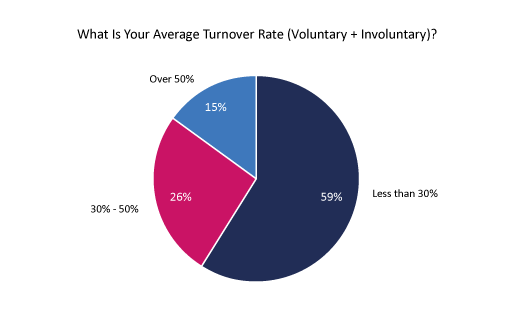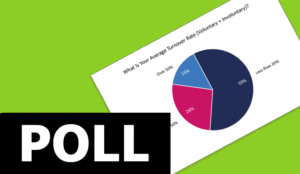Retention and recruitment are popular topics right now, with staffing shortages impacting a lot of the contact centre industry.
With this in mind, Diana asked our LinkedIn Community of industry professionals for their average turnover rate, and we wanted to share the results with you.
453 professionals responded to the poll and the results were interesting to say the least.

| Average Turnover Rate | Response % |
|---|---|
| Less than 30% | 59% |
| 30% – 50% | 26% |
| Over 50% | 15% |
There were only three options for participants to choose from and the most popular result of ‘less than 30%’ was the lowest people could select, so it is unclear the exact make-up of turnover rates in this category and exactly how promising a picture this truly is.
Meanwhile, 15% of respondents stated their turnover rate was ‘over 50%’, which is concerning as this would result in high recruitment costs for the business, as well as knock-on training costs and a loss of skills.
Additionally, with 26% saying their turnover rate was between ‘30% and 50%’, a concerning total of 41% of respondents have turnover rates over 30%.
It is, however, important to note that the poll looks at total turnover rate (Voluntary + Involuntary), rather than just voluntary or involuntary individually, which can also affect how we view the results – as due to current market and economic conditions, there may have been increased layoffs, which in turn can impact the total turnover rate.
In addition to voting on the poll, a number of respondents also elaborated on their selection by providing comments and insights – we’ve put together the best of these for you to look through:
Turnover Rate of 5% Is Frustrating
I get frustrated when our turnover rate is 5%, so I can’t imagine how someone could survive and retain clients with 30%!
We all know that contact centre employment is a stepping stone for most, but with turnover rates in those ranges, something is definitely going wrong.
I would start looking at the hiring process and the filters in place to select the right people and then analyse the training and onboarding support that is provided, as well as QA processes and the agent/supervisor relationship.
You’ve got to start by getting the right people on the bus and then work on keeping them on it!
Thanks to Emily
Many Factors Impact Attrition
Many factors impact attrition.
In our business, we see huge benefits from customer journey mapping, because you can expose areas of automation so your customer experience and agent experience are improved.
This gives your agents a sense of accomplishment and value-add because they get to handle high-value interactions and aren’t stuck doing the same mundane tasks over and over.
Thanks to Scott
There Is a Struggle to Recruit and Retain Skilled People
I used to see turnover of around 30–50% in most contact centres, but I spoke to someone today who had a 150% turnover rate – I couldn’t believe it!
Whilst this was extreme, it’s indicative of the struggle to recruit and retain skilled people who can cope with the demands being placed on some contact centres today.
Thanks to Craig
Positive Interactions = Job Satisfaction
Enterprise Branded Calling has also improved employee satisfaction rates due to higher answer rates, First Call Resolution and higher closed rates.
Employees are having more positive interactions, which equates to job satisfaction! Imagine the impact of customers not answering the phone…
It decreases job satisfaction if you can’t do what you were hired to do.
Thanks to Darcy
What About Fallout During Training?
For instance, some companies measure and report attrition only post-training. So fallout during training is not measured.
Thanks to Roseann
Attrition Should Be Followed Through the Whole Cycle
Attrition should be followed during the entire collaborators’ cycle in the company because they can have different root causes.
Examples:
- High attrition during training = poor trainer.
- Attrition in first 3 months = poor onboarding or wrong expectations set by recruitment.
After that period, it can be because of a lack of growing opportunities, remuneration, burnout, etc…
Attrition needs to be measured as a whole and using specific filters – tenure/project/language/etc…
Thanks to Pedro
To discover more great insights on staff turnover and attrition, read these articles next:
Author: Robyn Coppell
Published On: 2nd Mar 2023
Read more about - Contact Centre Research, Attrition, Research






































